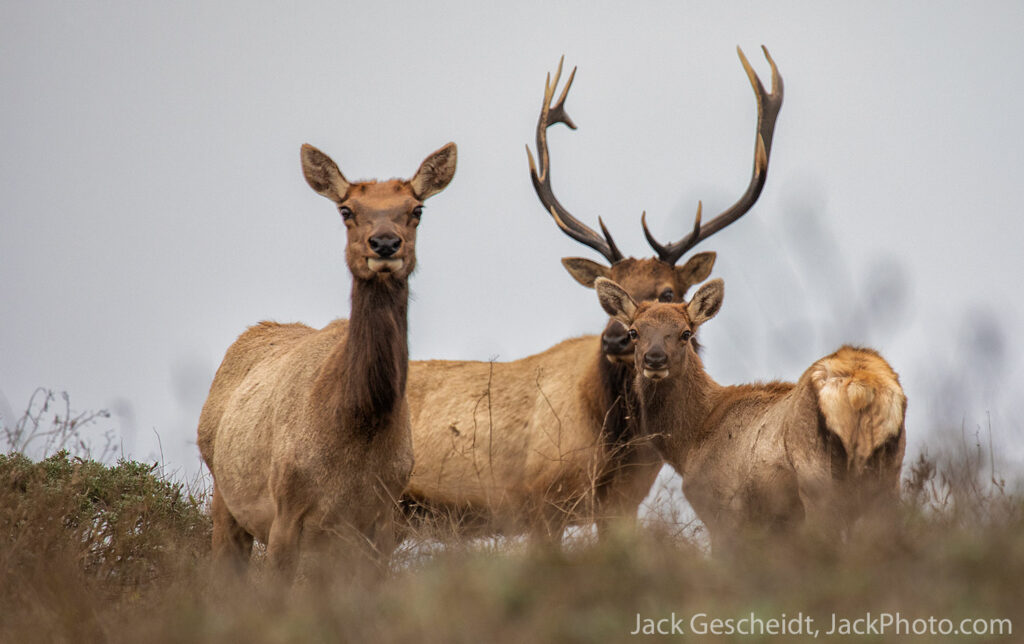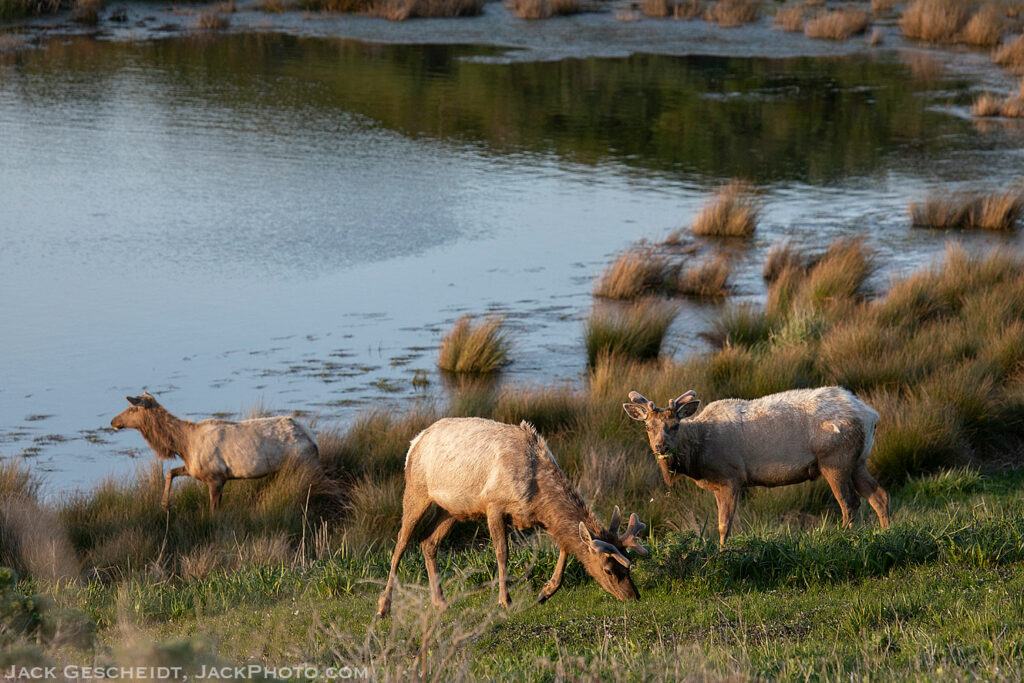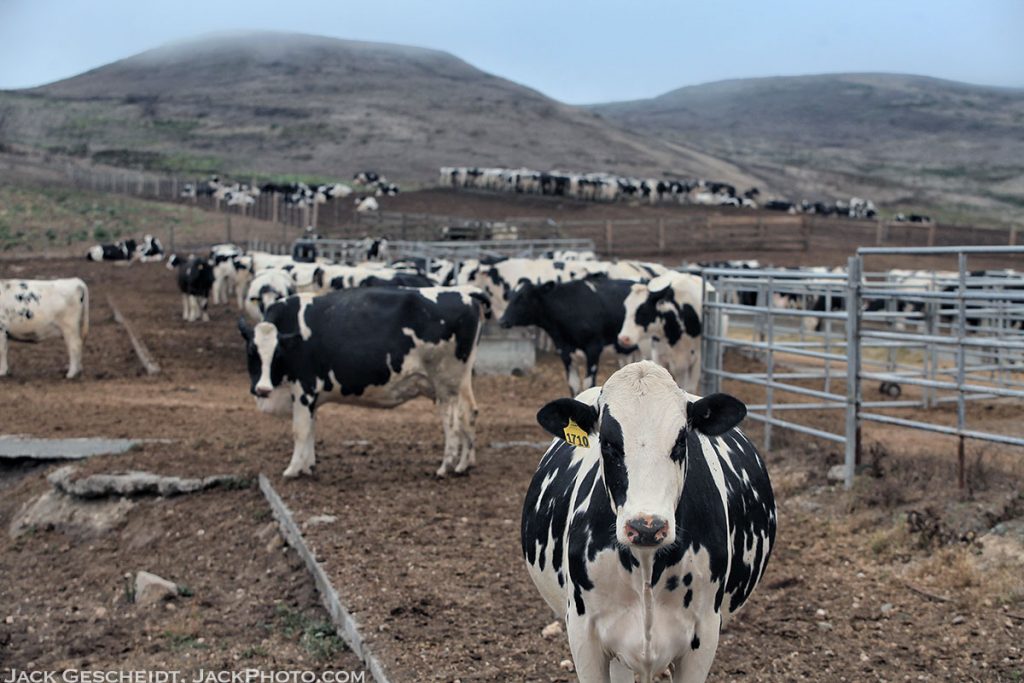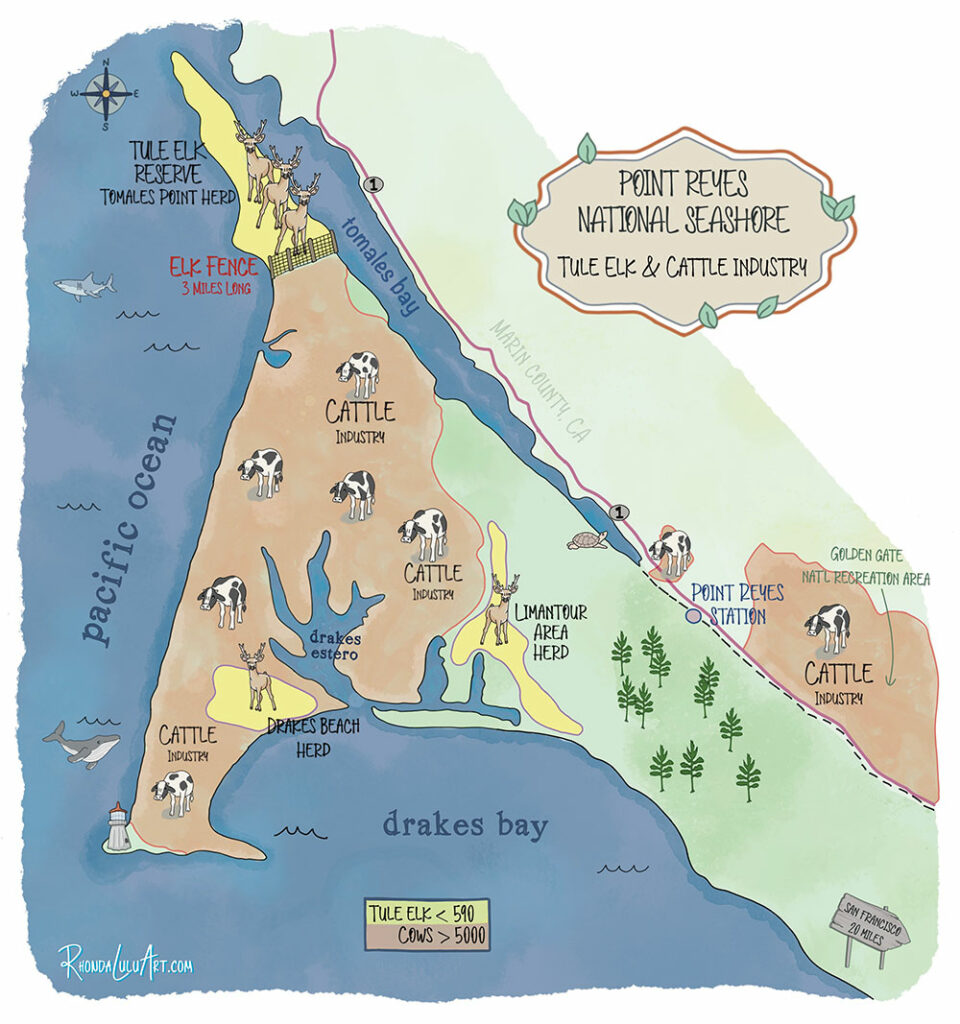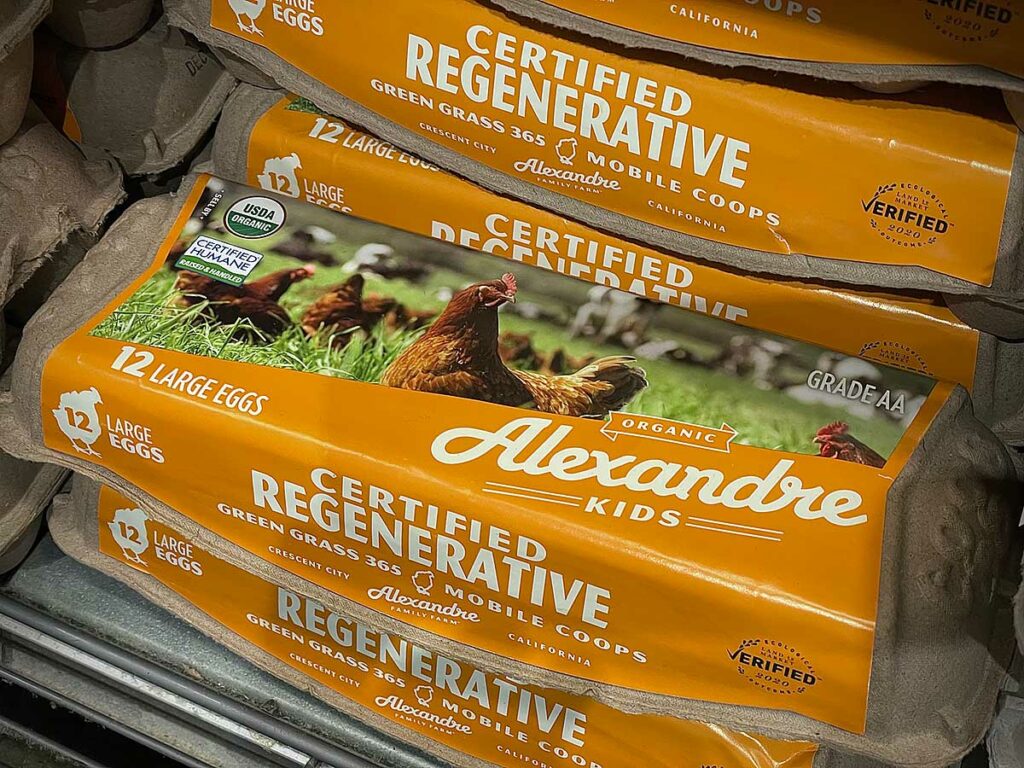If you’ve been wondering what’s up with the beautiful, vulnerable Tule elk of Point Reyes, here’s a Feb. 2024 update:
THE QUESTIONS:
• How are the park’s Tule elk doing right now? Do they have enough water to survive?
• Why haven’t the elk been freed yet? Hasn’t the National Park Service already taken down the deadly, infamous, 3-mile-long Tule Elk Reserve fence? If not, why not, and when will they do so?
• What about all the private dairy & beef ranches that are contaminating park waterways and thousands of acres of the Seashore with millions of gallons of manure and urine every year?
• Will these polluting private beef and dairy ranches ever, finally (be forced to) leave? Wasn’t this the Seashore’s 1962 founders’ original intention?
THE ANSWERS:
The park’s Tule elk are doing well right now, as of February 2024. This goes for all 3 of the park’s herds, including the infamous long-suffering herd trapped inside the fenced “Tule Elk Reserve.” The other two, smaller herds south of Tomales Point, outside the so-called Reserve, are not entirely free either, but their movements are less restricted. And they have access to more year-round water, so they fare better in the dry summer-winter season when food and water becomes more scarce inside the Reserve.
California’s rainy winter season typically fills the ponds in the Reserve. In fact, as of February, 2024, ponds are already full, and springs and streams everywhere are gushing from recent heavy rains. Vegetation is already lush, so elk have plenty of forage to eat. Thankfully, we expect these conditions to last into the summer. Then conditions will depend on how hot and dry the summer and autumn are. But fortunately this is when the fence may be scheduled for removal by the NPS (National Park Service).
FENCE REMOVAL, ELK FREEDOM
The NPS, which manages the park and its private cattle ranches, made an historic recommendation in June of 2023: to remove the fence of the approximately 2,600-acres Tule Elk Reserve. For the first time in 45-years, since the Reserve was first established in 1978, this herd of about 300 elk would have to access more of the entire park’s 71,000 acres.
But complicating matters are the many adjacent, private cattle ranches which occupy about 26,000 acres — about 1/3rd the entire park — some bordering the Elk Reserve. This creates more future conflict between private cows and wild Tule elk for several reasons including…
Cattle ranch manure pollution is ongoing at Point Reyes. These for-profit cattle businesses do not own land here; they only lease it from the federal government. Technically, the public owns their land. Ranchers want to stay here forever because they enjoy cheap, sub-market value lease rates negotiated with their prodigious political muscle — and subsidized by you, the American taxpayer.
READ the PEER (Public Employees for Environmental Responsibility) Report, Point Reyes Sweetheart Cattle Leases are Illegal: https://peer.org/point-reyes-cattle-leases-illegal/
This is just one of the cattle industry’s dirty, not-so-little secrets at Point Reyes which we activists keep broadcasting to the public and to the media. Constant publicity is necessary to counter the cattle industry’s extensive, multi-million dollar public relations campaigns. This includes, for example, years of regional billboard advertising depicting happy cows on green (manure-free) pastures, and myriod other mythologies about “hard-working,” “small,” “local,” “family farms” acting as “stewards of the land.” Don’t buy any of this bull. Ranchers are subsidized. Ranchers are major polluters. And the cattle industry is a major emitter of greenhouse gases. READ MORE.
Additionally, the park’s approximately 4,500 dairy and beef cows drink huge amounts of California’s precious, dwindling (summer-autumn season) aquifers. The exploited, confined cows trample thousands of acres of parkland to bare dirt. And put literally millions of gallons of manure and urine into park waterways: streams, bays, lagoons and the Pacific Ocean.
Two years of citizen-activist sponsored surface water testing — including IDA-sponsored testing, thanks to your support — has documented ongoing cattle ranch water contamination. This won media attention and raised public awareness. Which has been instrumental in stopping the NPS from giving new 20-year operating leases to the ranches. This is another major activist accomplishment.
Most recently, in November of 2023, the California Coastal Commission did NOT approve giving ranchers 20-year leases they lobbied hard for — amounting to another free pass to pollute. And that’s because we activists showed up, yet again, in force, and spoke to the Commission, driving home the extent of the cattle pollution, the continued violation of county, state and federal regulations. We countered the National Park Service’s attempts to downplay the previous 3 years of damning surface water testing reports documenting fecal contamination by cattle operations.
All the while, ranchers keep lobbying to continue their dying, killer businesses-as-usual. Seeing the turning tide of public sentiment in the last three years, they are doubling down on their old stories, including pleading poverty — never mentioning their substantial public subsidies (including Measure A county tax funds which should go to public parks, not private businesses which pollute public land and water. Again, part of our ongoing work is countering decades of false cattle industry narratives. These self-described “stewards of the land” are more like open sewers of the land.
2 LAWSUITS are still in process:
1) The Tomales Point Tule Elk Reserve lawsuit (which is northernmost Point Reyes National Seashore), brought by the Harvard Animal Law & Policy Program, awaits an appellate court date oral arguments hearing scheduled for April 1st, 2024. The case is now on appeal after the (lower) Oakland Superior Court decided last year in favor of the National Park Service (NPS). [NOTE: The results of this April 1, 2024 Appellate Court hearing are blogged HERE.]
Complicating matters is that since the lower court’s initial ruling, the National Park Service’s proposal to remove the Reserve’s fence potentially renders this entire case moot. Because if the fence comes down at the end of this year, the Elk Reserve is arguably no more, and less deadly to elk who will be freer to roam outside its existing boundaries to find more food and water.
But we “elktavists” speculate that elk will take months, even years, to adjust to the fence removal, especially by those elk who live 5+ miles north of the fence which is the Reserve’s current southern border. The Reserve has roughly four sub-herds who inhabit different areas of the Reserve (see tip of map below), and the northernmost herds, who are in most need of water are least likely to know when the fence is gone.
2) The 2nd lawsuit, brought by 3 environmental groups — Western Watersheds Project (WWP), Resource Renewal Institute (RRI) and The Center for Biological Diversity (CBD) — is more specifically focused on water pollution and other lease violations by Point Reyes cattle operations.
March 15, 2024 is the date currently set for the judge to issue a status report. This date, like so many court dates, is likely to be pushed back, as have so many dates in this ongoing case.
WHAT’S NEXT? – This spring (2024), the NPS is expected to release the results of its most recent public comments survey, part of the lengthy, legally required NEPA (National Environmental Policy Act) process. Tens of thousands of public comments were submitted, and we anticipate the vast majority will support the NPS own proposal to “remove” (dismantle) the Tule Elk Reserve fence. This would free the Tule elk herd confined within to roam larger areas of the park. And to access more water and food in California’s hot, dry summer-autumn season which made headlines in recent years by killing literally hundreds of elk.
MORE CATTLE RANCH PROBLEMS AHEAD – Once freed to wander south of the Reserve fenceline, Tule elk will inevitably be endangered by the private dairy and beef ranches. For one, ranchers will likely continue their decades-long lamentations about wild elk eating “their” grass and drinking “their” cattle water — hence the inherent problem with private ranches being inside any national park where all wild animals are, by law, prioritized, and supposed to roam free of any human harassment.
For another, beef and dairy cows commonly carry communicable cattle diseases, the result of typical overcrowding and poor health (regardless of farm size). For example, Johnes disease, which can be transmitted to elk via cow manure contamination of soil and waterways animals share, was found in a 1979 study to be present in 5 of 10 dairy herds tested at the Seashore.
All this puts the lie to the myth that domesticated animal herds don’t directly threaten and harm wild animal populations.
We also expect the cattle industry to continue its ongoing public relations propaganda war. This has already begun, with one prominent dairy operator publicly bemoaning the death of Marin County dairying should, heaven forbid, private cattle businesses are forced out of the Point Reyes national park unit they actively pollute. As if his business has a right to be there, which it does not; as if cattle ranches contribute to the public good, which they do not; and as if ranches aren’t doing major ecological damage, which they most certainly do. Which has been proven by professional, third-party surface water testing, as reported here: https://seaturtles.org/rigorous-new-study-finds-significant-water-pollution-from-cattle-ranching-at-point-reyes-national-seashore/
The cattle industry P.R. campaign includes further dissemination of their latest, trending non-science, “regenerative ranching.” This advertising phrase has no legal definition, and is merely piled atop the existing heaping pile of meaningless terms, like “sustainable” and “small” and “local” and “historic” and “family-owned” mind-worms memes. We have been conditioned to visualize specific images when we see or hear these words, and that is by design. Yet none of these terms have any precise meaning than the advertising words, “delicious” or “tasty” or “best.”
Only “organic” is a term registered with the USDA, and even organic standards have nothing to do with manure contamination of land, water and atmospheric methane pollution. Organic standards, also have nothing to do with animal confinement, animal abuse, animal cruelty, animal commodification and of course the slaughter of cows, pigs, chickens, sheep and goats. All of this is inherent in all cattle (and pig and chicken) operations, even though you have been conditioned to think otherwise. Or, better yet, not think about how animals die in order for humans to eat them every day. READ MORE.
The good news is that by the end of 2024, it’s more likely than not that the Tule Elk Fence will finally be dismantled by the National Park Service. This is an historic achievement made possible by a community of caring citizens, and activists, and environmental and animals rights activist groups. And your, the public’s support. Activism DOES work.
READ MORE about the Tule elk on this website’s page devoted to the issue: http://www.TreeSpiritProject.com/elk

